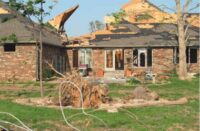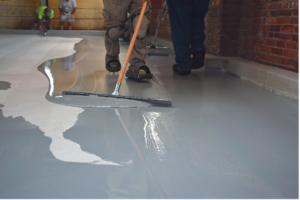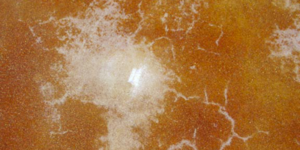
Thanks to the strength of concrete, many homeowners can rest assured that their homes will remain standing on a stable platform. But not even concrete is invulnerable. It might not immediately be clear, but every time it rains that same water may come to rest against your concrete foundation as it seeps down. It may also reach your foundation as the water table rises.
On a normal day, you may not notice anything happening. But water against your foundation slowly but surely interacts with your foundation’s concrete. Eventually, several things may happen to your concrete foundation. These can lead to various issues for your basement or crawlspace — and possibly the rest of your home.
How does moisture get into concrete?
Concrete by nature is porous, and this porosity is a natural byproduct of how concrete cures and dries. These potential voids in the concrete can allow moisture to enter and flow through the foundation.
As it travels through connected cavities, this invasive moisture may not only permeate the concrete. For spaces such as basements or crawlspaces, it can also result in increased indoor humidity. It may also cause mold to grow on the concrete.
While moisture may rise naturally from soil through evaporation, capillary action and hydrostatic pressure may also lead to moisture infiltrating concrete foundations.
Hydrostatic pressure
When it rains, water naturally saturates the soil and sinks downward. Some of this water may come to rest against the concrete foundation, while the rest joins the water table. But as the water table rises to meet the foundation, additional water has nowhere to go beyond the foundation.
Instead, further rain will cause the water table to rise until it oversaturates soil on all sides of the foundation. This creates an incredible amount of hydrostatic pressure on the concrete. It also leads to a variety of interactions between the concrete and the water.
Interactions of hydrostatic pressure on concrete
As hydrostatic pressure increases, the water against the concrete will seek the path of least resistance. For the water next to the foundation, the seams between walls and footers offer space to move. This also holds true for the seams between walls and floor slabs. Then there’s also the porous characteristics of the concrete itself.
With enough hydrostatic pressure, the concrete in a foundation wall or floor may begin to crack. These cracks can lead to water seeping deeper into the foundation. This allows moisture to penetrate deeper into the concrete and cause further stress.
Eventually, these cracks can grow until they reach the interior of a basement or crawlspace, resulting in water leaks. In addition to leakage, concrete basement floor cracks can possibly cause major damage to a home’s foundation.
If water leaks into the basement or crawlspace, evaporation will result in increased indoor moisture.
Moisture diffusion
With or without hydrostatic pressure interacting with concrete foundations, water molecules may still diffuse into the foundation through its many pores and capillaries. This can happen even when it’s not raining — it could just be moist soil next to the foundation.
Moisture diffusion can occur when a region of higher moisture concentration abuts another area. In this case, when moist soil lies against a relatively dry concrete foundation.
Capillary action
Concrete is a porous material that can absorb water through capillary action. Through the forces of surface tension, adhesion and cohesion, water can infiltrate concrete’s pores. In doing so, water can defy gravity and move upward into a foundation.
For an example that you can safely observe, try dipping a sponge into a shallow dish of water. Then watch the water move up through the sponge as it’s absorbed. You could also take a paper straw wrapper and dip the tip of it into water. Subsequently, you’ll see the water soak into the paper and move upward.
How moisture interacts within concrete
Through prolonged exposure, moisture or water in the concrete can lead to several interactions with negative outcomes.
Carbonation – Carbonation is a process that begins from the start. As carbon dioxide in the air flows into concrete’s pores, it interacts with concrete’s calcium hydroxide and calcium silicate hydrate.
Exposure to salt or acid rain can also lead to carbonation. The concrete becomes weakened as carbonation lowers the pH levels of the material. Any steel supports within the concrete may also experience corrosion during this process.
Mold Growth – Typically, mold requires an organic food source and moisture to survive. While concrete itself isn’t a food source for mold, it can collect moisture, bacteria, pollen, salt and even dirt to provide the sustenance that mold requires.
With enough food and moisture present on or within the concrete, mold will begin to grow and spread.
How mold interacts with concrete
Mold produces an acid that can harm the structural integrity of concrete. As the concrete breaks down, it can become more porous, allowing for more moisture infiltration. In turn, this can exacerbate any other moisture-related problems that the concrete experiences.
Mold can do more than harm concrete. It can also present a health hazard to a building’s inhabitants or visitors with mold infestation.
Health hazards of mold
Various kinds of mold can grow indoors. Certain mold species, such as black mold, can trigger allergic reactions and agitate symptoms for those with asthma. This is due to the spores they release as they colonize and grow. Some molds are also known to be toxic if their fungal fragments are ingested or inhaled.
Reducing the amount of moisture in concrete
There’s no way to completely prevent water from being near a building. However, you can take control of the situation and minimize the presence of water around a foundation.
Landscaping, trees and proper grading – The land around a foundation shouldn’t slope toward it. Improper grading can result in rainwater running toward a foundation. Properly grade the surrounding land so it slopes away from the building.
Check for trees situated too close to the foundation. As tree roots spread toward and under a foundation, they can create pathways for water. This may inadvertently lead to water collecting against the foundation. Situate gardens away from buildings. This will help ensure any water from a garden hose won’t accidentally seep into soil next to the foundation.
Gutters and downspouts – Maintain gutters and downspouts to keep rain from running off the roof and straight down to the foundation. Regularly clean gutters and downspouts of any debris. If able, extend downspouts away from buildings so rainwater has less chance of seeping toward foundations.
Waterproofing – Installing an interior basement waterproofing system can help reduce the hydrostatic pressure that a foundation may experience.
As the water table rises to meet the foundation, drainage channels along the perimeter of the basement will collect and redirect that water toward a sump pit. A sump pump then pushes the water out of the home. Subsequently, it deposits the water away from the foundation through a discharge pipe.
Contact an expert in waterproofing and foundation repair
Moisture and water can harm the concrete in your foundation in many ways. Preparing your concrete foundation against the effects of water and moisture can be quite involved. But with the help of an experienced waterproofing and foundation repair company, you can have an expert inspect your foundation and determine how to best protect it.
Do your research and ensure the company you choose is a licensed and insured contractor with many years of experience. That company should also have a strong warranty backed by the company’s many years of business.
















